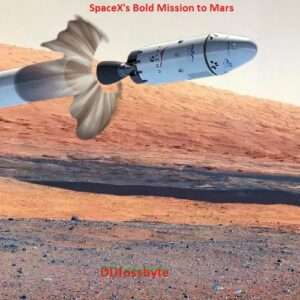SpaceX, the pioneering aerospace company founded by Elon Musk, is making headlines with its audacious mission to Mars.

Here, we will delve into the intricacies of SpaceX’s bold venture and explore the significance of their journey to the Red Planet.
The Visionary Leader:
Elon Musk At the heart of SpaceX’s Mars mission lies the vision of its enigmatic founder and CEO, Elon Musk. Musk has long been fascinated by the idea of making humanity a multiplanetary species, and his commitment to this goal is the driving force behind SpaceX’s ambitious undertaking.

The Plan:
A Multi-Step Approach
SpaceX’s mission to Mars is not a one-off event but a multi-step process designed to establish a sustainable human presence on the planet. The key components of this plan include:
- Starship: SpaceX’s colossal spacecraft, known as Starship, will serve as the primary vehicle for transporting humans and cargo to Mars. Starship is being developed with the capacity to carry a large number of passengers, making it the cornerstone of SpaceX’s Mars colonization efforts.
- Crewed Missions: SpaceX plans to conduct a series of crewed missions to Mars, gradually building up the infrastructure required for a thriving human settlement. These missions will involve sending astronauts to conduct research, test life-support systems, and pave the way for future colonization.
- In-Situ Resource Utilization (ISRU): To ensure long-term sustainability on Mars, SpaceX intends to utilize the planet’s resources, such as water ice, to produce essential supplies like oxygen and fuel. ISRU is a crucial element in reducing dependence on Earth for resources.
- Terraforming: While a full-scale terraforming of Mars is a long-term goal, SpaceX acknowledges the immense challenges involved. Nevertheless, they remain committed to exploring ways to make Mars more hospitable for humans, including the possibility of creating localized environments suitable for agriculture and habitation.

The Challenges Ahead
SpaceX’s mission to Mars is not without its formidable challenges. Some of the major obstacles include:
- Technological Hurdles: Developing the necessary technology for Mars colonization, including life support systems, radiation protection, and efficient propulsion, is an immense undertaking.
- Financial Resources: The Mars mission requires substantial financial investments, and SpaceX is actively seeking partnerships and funding opportunities to support its endeavors.
- Environmental Considerations: Ethical and environmental concerns are crucial factors in SpaceX’s approach to Mars. They are committed to minimizing contamination and preserving the pristine Martian environment.

The Broader Implications
SpaceX’s mission to Mars has far-reaching implications for the future of space exploration and humanity as a whole. It rekindles our dreams of venturing beyond Earth and opens up new possibilities for scientific discovery, resource utilization, and the eventual survival of our species.

SpaceX is developing a reusable spacecraft called Starship that could make human travel to Mars a reality. Starship is designed to be capable of carrying up to 100 passengers and 100 tons of cargo to Mars.
If the uncrewed mission is successful, SpaceX plans to launch its first crewed Starship mission to Mars in 2026. This mission will carry the first humans to Mars in over 50 years.

SpaceX’s mission to Mars is a bold and visionary quest that promises to reshape our understanding of space exploration. While the challenges are daunting, the potential rewards are equally immense, making this venture a historic endeavor that will be watched with anticipation by people around the world.
